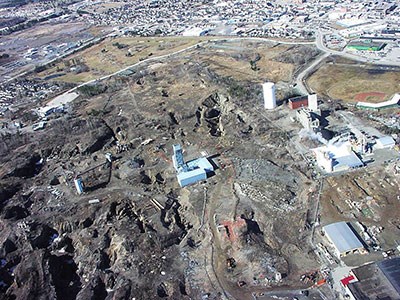Development work on Goldcorp’s Hollinger open-pit mine in Timmins is progressing steadily, following ramp-up last October.
Goldcorp’s Brendan Zuidema, general manager of Porcupine Gold Mines (PGM), the Timmins-area division of Goldcorp, and Don Burke, general manager of the Hollinger Mine, visited city council in March to provide an update on the work done so far.
Progress is slowly becoming more visible, Burke said: the topography is levelling out and walls are starting to form inside the pit.
“The pit is actually starting to look like a real pit, so things are progressing extremely well,” he said.
Manpower has ramped up as well. The company now has 113 operational personnel and 42 contractors at the site. Maintenance staff numbers 44 employees and technical staff remains steady at 165 employees.
Burke said PGM has been working to reduce the number of contractors on site and increase the number of PGM employees.
There are three main areas to the Hollinger Mine: the 92 pit to the south of the property, the Central pit to the northeast, and Millerton. The company has been focusing its efforts on building up 9-metre benches.
“Over the months of October, November and December, a lot of the mining activities have been focused on the 92 pit area,” although more work is starting to be done the Central pit, Burke said.
“There won’t be a lot of work in the Millerton in 2016,” he added. “There will be some pioneering and levelling of the landscape later in the year, but for the most part, 2016 will be focused on the 92 pit and the Central pit.”
The pit’s ultimate depth could change over time as PGM strives to make it as efficient an operation as possible, he noted. But, using current numbers, at its deepest, the Central pit will reach a depth of 168 metres, at the 3,232 elevation.
Over the fourth quarter of 2015, PGM blasted 2.3 million tonnes of ore and waste, an increase from 1.5 million tonnes during the third quarter.
“So you can see a ramp-up in October when we went to full production,” Burke said.
The rate of blasting now remains steady at around 800,000 to 900,000 tonnes per month, he added.
While developing the site, the company is also managing community feedback.
In the fourth quarter of 2015, the company received 73 “feedback events,” including 35 complaints, the majority of which were related to noise. But not all noise was related to activities at Hollinger; some came from the Dome site, which is slated to close by the end of July.
“PGM has put noise sensors in that proximity and right now is working on, is there noise coming in that direction attributed to the Dome Mine site,” Burke said.
Burke said all property issues had been investigated and resolved by a third party. Noise complaints had additionally been investigated, and “monitoring information showed any of the operations were well below target levels.”
The company has been equally vigilant in monitoring environmental exceedances for dust, vibration overpressure and noise. In one particularly baffling situation, the company returned five vibration exceedances in one location.
“What we found is the vibration monitor located there…was being influenced by previous underground workings,” Burke said. “Through consultation with the Ministry of Environment and the Hollinger Project Community Advisory Committee, we moved that sensor to a much more representative area and we have had no vibration exceedances since then.”
In January, the company reduced the number of noise exceedances from 419 to 121. In February, that number was further reduced to 99 noise exceedances, and nearing the end of March, the numbers had been lowered to 81.
Most of the noise is related to the haul trucks travelling Hallnor Road, which leads to the mine site. Most of the exceedances have occurred at night and hovering around 46 decibels, just one decibel over the allowable limit.
But PGM is continuing to implement measures to reduce those numbers further, by installing louvres or baffles around the haul trucks to contain the noise, Burke said. The company has even introduced a challenge to operators to reduce the noise; winners get pizza as a token of thanks to “reinforce efforts to reduce noise,” Burke said.
The company is also employing BarnOwl, a noise monitoring system that monitors noise from a 365-degree radius and can detect what noise is specifically coming from mining-related activities. PGM is still awaiting Ministry of Environment approval for use of that technology.
Zuidema, who oversees the Hollinger project, said following a slow startup last year, PGM is still working out the bugs surrounding the mine and still has a long way to go.
“The gold price has gone up a bit, the exchange has come down — we still do a lot of stuff in American dollars, a lot of stuff we buy — so there are still some tradeoffs,” he said.
“There’s still a long way to go.”
Currently, activities at Hollinger are slated to close at the end of 2019, although Zuidema said that could change once the grade of ore is further analyzed as development continues.




